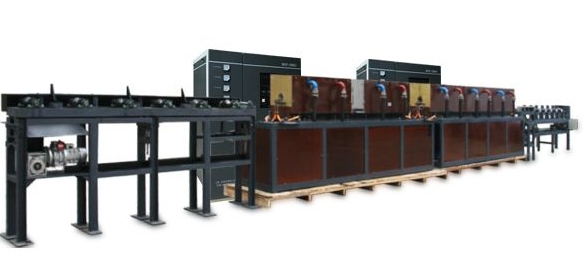- 30
- Nov
Hydraulic rod, push-pull rod quenching and tempering production line
Hydraulic rod, push-pull rod quenching and tempering production line
1. Technical requirements
1. Purpose
Used for overall heating and tempering of hydraulic rods and push-pull rods.
2. The parameters of the workpiece
1 ) Product material: 45 # steel, 40Cr , 42CrMo
2 ) Product model (mm) :
Diameter: 60 ≤ D ≤ 150 (solid round steel)
Length: 2200mm ~ 6000mm ;
3 ) The round steel is heated to the quenching temperature by intermediate frequency and then cooled for quenching treatment, and tempering treatment is performed on-line.
Quenching heating temperature: 950 ± 10 ℃;
Tempering heating temperature: 650 ± 10 ℃;
4 ) Input voltage: 380V ± 10%
5 ) Output requirement: 2T/H ( subject to 100mm round steel)
3. Technical requirements for equipment quenching and tempering:
1 ) The overall surface hardness of the entire shaft is 22-27 degrees HRC , the minimum hardness cannot be less than 22 degrees, and the appropriate hardness is 24-26 degrees;
2 ) The hardness of the same shaft must be uniform, the hardness of the same batch must also be uniform, and the uniformity of a shaft must be within 2-4 degrees.
3 ) The organization must be uniform and the mechanical properties meet the requirements:
a. Yield strength is greater than 50kgf/mm ²
b. Tensile strength is greater than 70kgf/mm ²
c. Elongation is greater than 17%
4 ) The lowest point of the center of the circle shall not be lower than HRC18 , the lowest point of 1/2R shall not be lower than HRC20 degrees, and the lowest point of 1/4R shall not be lower than HRC22 degrees.
2. Workpiece specifications
According to the requirements of the buyer, we provide the following sets of sensors for the 45-150 round steel
| Serial number | Specification | Scope | Length (m) | Adaptation sensor |
| 1 | 60 | 45-60 | 2.2-6 | GTR-60 |
| 2 | 85 | 65-85 | 2.2-6 | GTR-85 |
| 3 | 115 | 90-115 | 2.2-6 | GTR-115 |
| 4 | 150 | 120-150 | 2.2-6 | GTR-150 |
According to the workpiece specification table provided by the buyer, a total of 4 sets of inductors are required, 4 sets each for quenching and tempering . The heating range of the workpiece is 40-150mm . The quenching temperature rise sensor adopts 800mm × 2 design, the quenching uniform temperature sensor adopts 800mm × 1 design, and the quenching heat preservation inductor adopts 800mm × 1 design to ensure uniform heating. The tempering part is designed in the same way.
Three, process flow description
First, manually place the workpieces that need to be heated in a single row and a single layer on the feeding storage rack, and then the material is slowly sent to the feeding rack by the loading machine, and then the material is pushed into the feeding inclined roller by the air cylinder. The inclined roller drives the bar material forward and sends the material to the quenching heating inductor. Then the workpiece is heated by the quenching heating part, and the quenching heating is divided into quenching heating heating and quenching heat preservation heating. In the quenching and heating part, a 400Kw intermediate frequency power supply is used to heat up the workpiece, and then two sets of 200Kw intermediate frequency power supplies are used for heat preservation and heating.
After the heating is completed, the workpiece is driven by the inclined roller to pass through the quenching water spray ring for quenching. After quenching is completed, it enters the tempering heating inductor for tempering heating. Tempering heating is also divided into two parts: tempering heating and tempering heat preservation. The heating part uses a 250Kw intermediate frequency power supply, and the heat preservation part uses two sets of 125Kw intermediate frequency power supplies. After the heating is completed, the material is discharged, and the next process is carried out.

